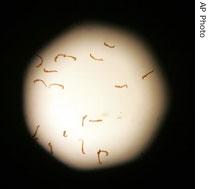VOA慢速英语 2008 0326a
搜索关注在线英语听力室公众号:tingroom,领取免费英语资料大礼包。
(单词翻译)
Health Report - New Drug Shows Promise Against Worm Disease
Experts worry that the parasite1 that causes schistosomiasis could become resistant2 to an existing treatment. Transcript3 of radio broadcast:
25 March 2008
This is the VOA Special English Health Report.
 |
| Schistosoma mansoni, one of three major kinds of worms that cause schistosomiasis |
Scientists think they are a step closer to a new drug to treat schistosomiasis. More than two hundred million people suffer from this parasitic4 worm disease. Most live in developing nations in tropical climates. About ten percent of victims become seriously disabled from internal bleeding, iron loss, organ damage or other effects.
A team in the United States found that chemical compounds known as oxadiazoles can target an enzyme5 needed for the survival of Schistosoma. This is the group of flatworms that cause schistosomiasis.
The scientists tested oxadiazoles on laboratory mice. They found that one compound killed the parasite at every level of development – from larva to adult. The study also showed that the compound was active against all three major species of Schistosoma worms that infect humans.
The National Institutes of Health supported the research. Scientists from Illinois State University and the Chemical Genomics Center at N.I.H. reported their findings in the journal Nature Medicine.
Biology professor David Williams led the research. He says the Schistosoma parasite needs oxygen to survive. Oxygen use produces oxygen-free radicals6 that can destroy an organism. The worm has a protective enzyme. But Professor Williams says the experimental drug disables this enzyme, causing the worm to self-destruct.
Since the nineteen eighties, doctors in more than seventy tropical nations have used one main drug to treat schistosomiasis. Public health experts worry that the worms will become resistant to this drug, praziquantel.
Each year, two hundred eighty thousand people die of schistosomiasis, also known as bilharzia or snail7 fever. The microscopic8 worms infect snails9, which in turn lay infected eggs. Humans become infected when they enter fresh water where the snails live.
The worms dig through skin to enter the body. They move into blood vessels10 that supply the intestinal11 and urinary systems. Then, if worm eggs in human waste enter fresh water, more snails and people become infected.
More studies are needed on the experimental new drug. The scientists say the results in mice were better than all the targets set by the World Health Organization for new schistosomiasis compounds. They hope the drug will be ready for testing in humans in four to five years.
And that’s the VOA Special English Health Report, written by Jill Moss12. Transcripts13, MP3s and podcasts of our reports are at voaspecialenglish.com. I’m Steve Ember.
 收听单词发音
收听单词发音 




